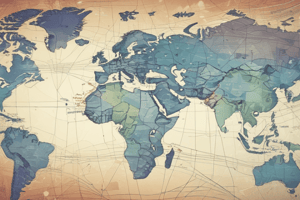Podcast
Questions and Answers
Which transportation method is best suited for transporting large quantities of perishable goods over long distances?
Which transportation method is best suited for transporting large quantities of perishable goods over long distances?
- Truck Transport
- Rail Transport
- Water Transport
- Air Transport (correct)
When choosing a distribution strategy for international markets, what is the key advantage of standardization?
When choosing a distribution strategy for international markets, what is the key advantage of standardization?
- It ensures the company can leverage successful strategies from other markets. (correct)
- It reduces the complexity of managing different strategies for each country.
- It allows for greater flexibility in meeting local needs.
- It gives the company more control over the distribution process.
If a company prioritizes the lowest possible cost for shipping large quantities of non-urgent goods, which transportation method should they choose?
If a company prioritizes the lowest possible cost for shipping large quantities of non-urgent goods, which transportation method should they choose?
- Pipeline Transport
- Truck Transport
- Water Transport (correct)
- Rail Transport
Which transportation method is considered to have the highest initial investment cost but offers high reliability and low operating costs after setup?
Which transportation method is considered to have the highest initial investment cost but offers high reliability and low operating costs after setup?
What is a potential drawback of adopting a differentiation strategy for international distribution?
What is a potential drawback of adopting a differentiation strategy for international distribution?
A business needs to transport large quantities of coal to a power plant located several hundred miles away. Which transportation method would be the most appropriate?
A business needs to transport large quantities of coal to a power plant located several hundred miles away. Which transportation method would be the most appropriate?
Which type of utility is created by providing a product in a ready-to-use format, such as pre-cut vegetables?
Which type of utility is created by providing a product in a ready-to-use format, such as pre-cut vegetables?
A website offering detailed product specifications and customer reviews is primarily providing which type of utility?
A website offering detailed product specifications and customer reviews is primarily providing which type of utility?
Which of the following is NOT a rule for effective international distribution?
Which of the following is NOT a rule for effective international distribution?
Which of the following is NOT a valid advantage of using the same distribution channels in every country?
Which of the following is NOT a valid advantage of using the same distribution channels in every country?
Which of the following could be considered an internal factor influencing channel decisions?
Which of the following could be considered an internal factor influencing channel decisions?
When a company chooses to utilize an intensive distribution network, which of the following product types is it likely to be targeting?
When a company chooses to utilize an intensive distribution network, which of the following product types is it likely to be targeting?
What is a key consideration when determining the length of a distribution channel?
What is a key consideration when determining the length of a distribution channel?
Which of the following is NOT considered a factor in managing and controlling distribution channels?
Which of the following is NOT considered a factor in managing and controlling distribution channels?
What is the main advantage of using a distribution approach significantly different from competitors?
What is the main advantage of using a distribution approach significantly different from competitors?
Which of the following is a primary consideration when establishing distribution channels in a new market?
Which of the following is a primary consideration when establishing distribution channels in a new market?
What is the role of a distribution channel in the context of the product's life cycle?
What is the role of a distribution channel in the context of the product's life cycle?
Which of the following is an example of an external factor impacting channel decisions?
Which of the following is an example of an external factor impacting channel decisions?
Which of the following is NOT a factor influencing the choice between direct and indirect involvement in a distribution channel?
Which of the following is NOT a factor influencing the choice between direct and indirect involvement in a distribution channel?
What type of intermediary is a wholesaler?
What type of intermediary is a wholesaler?
Which of the following is NOT an example of a facilitator in a distribution channel?
Which of the following is NOT an example of a facilitator in a distribution channel?
What is the main advantage of using an indirect involvement approach in a distribution channel?
What is the main advantage of using an indirect involvement approach in a distribution channel?
What is the main difference between a broker and a manufacturer's representative?
What is the main difference between a broker and a manufacturer's representative?
What is the primary focus of channel width?
What is the primary focus of channel width?
A company that uses a mix of both direct and indirect involvement in its distribution channel is likely to have what?
A company that uses a mix of both direct and indirect involvement in its distribution channel is likely to have what?
Which of the following is NOT an example of a direct involvement distribution strategy?
Which of the following is NOT an example of a direct involvement distribution strategy?
Flashcards
Rail Transport
Rail Transport
Best for large, heavy goods over long distances like coal and automobiles.
Water Transport
Water Transport
Best for large, low-cost shipments like oil and grain, limited to port areas.
Truck Transport
Truck Transport
Ideal for consumer goods and perishables; offers high speed and flexible routes.
Air Transport
Air Transport
Signup and view all the flashcards
Pipeline Transport
Pipeline Transport
Signup and view all the flashcards
Direct Involvement
Direct Involvement
Signup and view all the flashcards
Indirect Involvement
Indirect Involvement
Signup and view all the flashcards
Distribution Channels
Distribution Channels
Signup and view all the flashcards
Merchants
Merchants
Signup and view all the flashcards
Agents
Agents
Signup and view all the flashcards
Facilitators
Facilitators
Signup and view all the flashcards
Channel Strategy
Channel Strategy
Signup and view all the flashcards
Factors Influencing Channel Width
Factors Influencing Channel Width
Signup and view all the flashcards
Customer Characteristics
Customer Characteristics
Signup and view all the flashcards
Nature of Product
Nature of Product
Signup and view all the flashcards
Nature of Demand
Nature of Demand
Signup and view all the flashcards
Competition in Channels
Competition in Channels
Signup and view all the flashcards
Legal Regulations
Legal Regulations
Signup and view all the flashcards
Channel Length
Channel Length
Signup and view all the flashcards
Intermediary Selection
Intermediary Selection
Signup and view all the flashcards
Logistics Management
Logistics Management
Signup and view all the flashcards
Distribution Channel Structure
Distribution Channel Structure
Signup and view all the flashcards
Standardization
Standardization
Signup and view all the flashcards
Differentiation
Differentiation
Signup and view all the flashcards
Place Utility
Place Utility
Signup and view all the flashcards
Types of Utility
Types of Utility
Signup and view all the flashcards
Study Notes
International Marketing Distribution Channels
- Companies expanding internationally must decide how to structure their distribution channels.
- Standardization: Using the same channels in every country.
- Advantage: Leverages successful strategies from other markets, learning from past experiences.
- Disadvantage: Can make the company overly dependent on partners in different countries.
- Differentiation: Adapting distribution channels to specific country conditions.
- Advantage: Offers more flexibility to meet local needs, regulations, and preferences.
- Disadvantage: Increased costs and complexity in managing multiple strategies.
Channel Utility
- Marketing channels add value to products by making them accessible.
- Place Utility: Product availability where customers need it (e.g., vending machine).
- Time Utility: Product availability when customers want it (e.g., 24/7 online store).
- Form Utility: Product prepared for use or according to customer preferences (e.g., pre-cut vegetables).
- Information Utility: Providing helpful details about the product (e.g., product features, benefits, usage).
Channel Decisions – External and Internal Factors
- External Factors:
- Customer Characteristics: Customer demographics, shopping habits, outlet preferences, and sociocultural influences impact channel choice. Customers in geographically dispersed areas might require longer channels. Products with lower prices and high turnover need more intensive distribution.
- Nature of Product: Product pricing, complexity, and durability influence channel choice. High-value goods, like prestige products, might not need wide distribution. Industrial goods with high transportation and warehousing costs necessitate careful channel selection.
- Internal Factors:
- Intermediary Decisions: Types, level, and control of distribution channels needed (intensive, selective, exclusive).
- Channel Management: Screening and selecting intermediaries, contracting, motivating, and controlling to ensure effective distribution.
- Logistics Management: Physical movement of goods through the channel. Includes order handling, transportation, inventory management, warehousing.
Establishing Distribution Channels
- Direct Involvement: Company manages its own sales force or retail stores (e.g., Apple Stores).
- Advantage: Greater control, branding, pricing, customer experience.
- Disadvantage: High investment costs, high operational complexity.
- Indirect Involvement: Company partners with independent agents, distributors, or wholesalers (e.g., McDonald's franchise).
- Advantage: Lower upfront costs, quicker market entry.
- Disadvantage: Less control over customer experience and brand consistency.
Distribution Intermediaries
- Merchants: Buy and resell products, taking ownership.
- Wholesalers: Bulk purchases from manufacturers and resell to retailers.
- Retailers: Direct consumer sales.
- Agents: Help with sales negotiations but do not own goods.
- Brokers: Connect buyers and sellers.
- Manufacturer representatives: Sell products for manufacturers.
- Facilitators: Assist distribution without owning goods.
- Transportation companies
- Independent warehouses
- Banks
- Advertising agencies
Factors Influencing Channel Width
- Product Type: Differentiates product types by need and distribution (intensive, selective, exclusive).
- Product Life Cycle: Products are placed in different channels (intensive, selective, or exclusive).
- Product Price: More expensive products require more selective or exclusive distribution.
- Brand Loyalty: Preferred and non-preferred brands demand different distribution strategies.
Transportation Methods
- Rail: Best for large, heavy goods over long distances.
- Water: Best for large bulk shipments, but slow.
- Truck: Best for consumer goods, flexibility, and speed.
- Air: Best for urgent, valuable, perishable goods.
- Pipeline: Best for liquid or gaseous items.
- Internet: Best for digital goods delivery.
Selecting International Distributors
- Focus on distributors who can develop markets and are long-term partners.
- Support them with resources and knowledge to grow sales.
- Build relationships with national distributors early on to create a strong network.
Studying That Suits You
Use AI to generate personalized quizzes and flashcards to suit your learning preferences.




